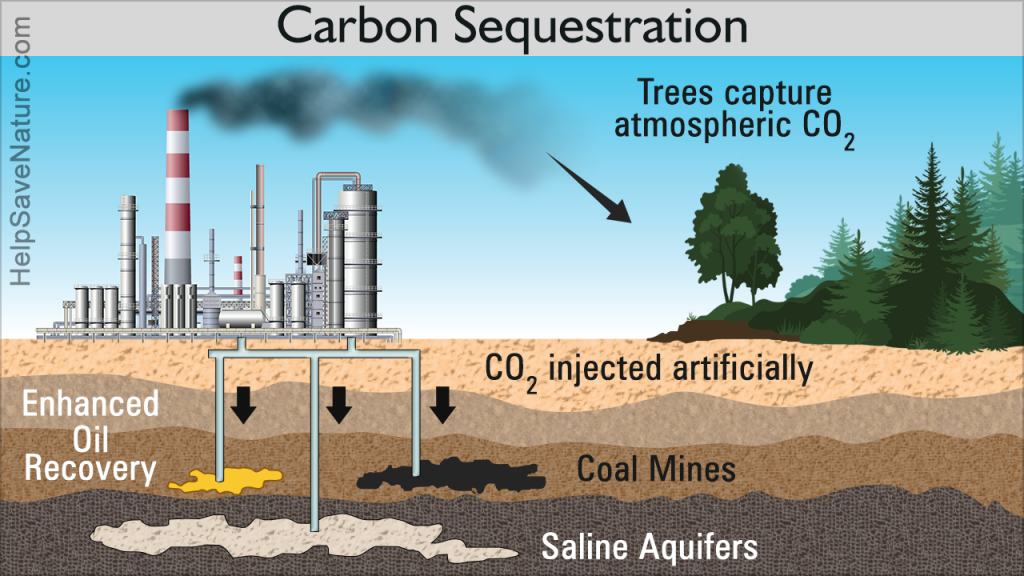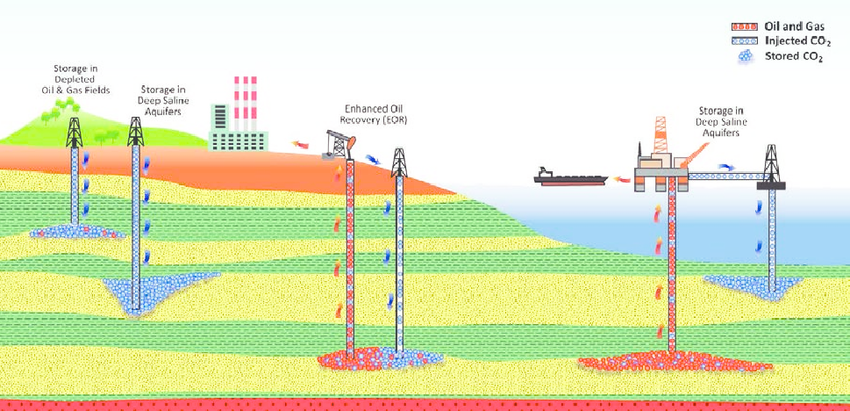Climate Change and Microbes (Carbon Sequestration)

What is Carbon Sequestration?
Carbon Sequestration is the act of taking carbon dioxide that is present in the atmosphere and storing it elsewhere. (2) This is typically carried out by Carbon Capture and Storage (CCS) methods. (3)

-Geological storage-
In this type of storage, the CO2 is injected into porous rocks. This can also be done by converting the sedimentary basins, depleted oil reservoirs, and non-economical coal beds into CO2 storage. There are several industrial-scale carbon storage programs currently running which includes the Norwegian Sleipner project in the North Sea and the Weyburn project in Canada, at these site millions of carbon dioxide is inserted into the surface (9). Despite this large annual injected volume of carbon dioxide, the project currently stores less than 0.01% of global annual carbon production (9).
-Ocean storage-
This means the injection of captured carbon dioxide into the oceans that are 1000 meters deep or greater. The carbon dioxide here will dissolve into the ocean and be a part of the global carbon cycle (9). This storage method is done at a pilot scale. The ocean storage capacity can be enhanced by the formation or creation of carbon dioxide lakes on the ocean floor (9).

-Mineral Carbonation-
This aims to create stable carbonated minerals like magnesite and calcite by reacting different silicate minerals containing magnesium and calcium with carbon dioxide (9) this minimizes the risk of carbon leakage back to the atmosphere. The positive effect of this method is that this material could be used as a building material, additive in paper or concrete, to improve soil texture, pH, and fertility of low-productive soil (9).
-Assisted Sequestration-
Large CO2 producing companies are able to capture and store CO2 in porous rock layers and cleared coal mines. CO2 can also be used in a method called enhanced oil recovery where it is used to increase pressure in oil reserves ensuring all the oil has been collected(2-3).
-Natural Sequestration-
Ecosystems have been sequestering carbon without assist from humans as CO2 is needed in the process of photosynthesis to provide energy to the plant in the form of glucose. The plant then utilizes glucose to grow roots in the soil and store CO2(4)
Where Does Carbon Come From?
Anthropogenic Activities
There are many anthropogenic activities linked to this increase, but the burning of fossil fuel is the primary reason for this increase since the industrial revolution(7).
Carbon emission from combustion of Fossil Fuels: About 6.5 billion tons of Carbon is being dumped into the atmosphere through the combustion of fossil fuels(7). Results have shown that there will be a 100% increase in the pollution level to that of the pre-industrial era due to an increase in demand for fossil fuel for industrial growth (7).
Industrial Emission: Industries are the major contributor to the emission of greenhouse gases. Fossil fuel is a vital source of energy for industries. Three major industries that contribute to this emission are the waste management industry, energy generation industry and chemical processing industry (7).
Overpopulation: Rapid carbon emission can be directly linked to population growth as there is an increase in the demand for more energy (7).
Natural Source
Forest Fire: Forests are considered as a good source of Oxygen and help in reducing environmental carbon, but it acts as a good source of CO2 when it catches fire. The severity of wildfires has increased due to human-generated climatic changes such as increased temperature, dry conditions, low humidity levels and thermal inversions (7).
Carbon Cycle

The global carbon cycle is dependent on microorganisms that fix atmospheric carbon, degrade organic material, and promote plant growth. These microbes even fix methane and nitrogen, they break down these components with help of enzymes to utilize to form energy (10). The microorganisms play a key role in determining the stability of carbon, which means whether to release it into the atmosphere or not. They also break down the dead organic material into forms that can be reused by other organisms like plants. Microbes even utilize carbon for growth and reproduction. Methane is also a major contributor to greenhouse gases, some microbes even utilize methane as their only source of energy, like methanotrophic bacteria. These bacteria can consume a huge amount of methane which can help reduce the methane production from factories and industries that produces methane. Scientists are using microbes and their enzymes to get rid of the carbon. They have found microbes that eat on oils and even CO2, that degrade the plastic, and even microbes that live in the gut of animals to control methane emission (10).
References
- Prud’homme GJ, Draghia-Akli R, Wang Q. 2007. Plasmid-based gene therapy of diabetes mellitus. Gene Therapy. [accessed 2021 Oct 17]; 14(7): 553-564. doi: 10.1038/sj.gt.3302907
- What is Diabetes?| 2 Minute Guide | Diabetes UK. 2018 Apr 10. Diabetes UK. 2:22. https://www.bjbms.org/ojs/index.php/bjbms/article/
- Immune System Research. 2016. National Institute of Allergy and Infectious Diseases. [accessed 2021 Nov 6]. https://www.niaid.nih.gov/research/https://www.bjbms.org/ojs/index.php/
- Zhang JM, An J. 2007. Cytokines, inflammation, and pain. International Anesthesiology Clinics. [accessed 2021 Nov 6]; 45(2): 27-37. doi: 10.1097/AIA.0b013e318034194e
- BJBMS. 2016. Apoptosis in pancreatic β-islet cells in Type 2 diabetes. [accessed 2021 Oct 18]; 16(3). https://www.bjbms.org/ojs/index.php/bjbms/article/view/919
- Crueso JR, Postigo-Fernandez J, Teteloshvili N. 2018. Altered Function of Antigen-Presenting Cells in Type 1 Diabetes: A Challenge for Antigen-Specific Immunotherapy. NCBI. [accessed 2021 Oct 17];
